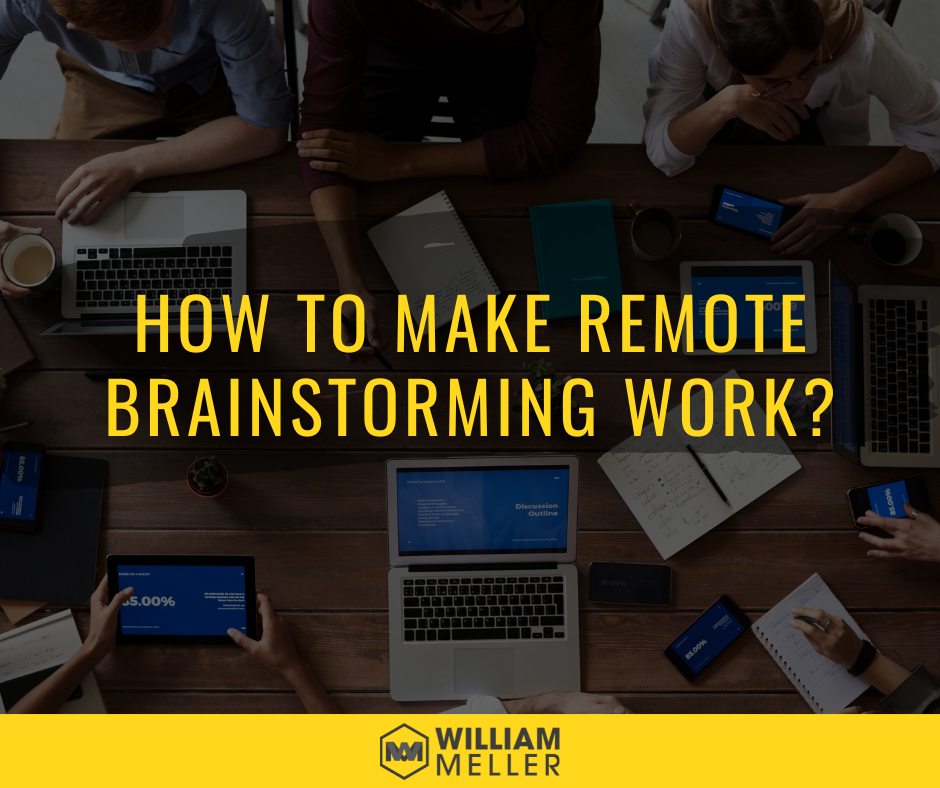
Organizing a brainstorming session doesn't have to be an upsetting task. Many of us no longer work together in the same room, but we still need to share ideas.
During brainstorming, group members are encouraged to come up with solutions to a particular problem by spontaneously contributing their own ideas.
Negotiations, crucial business decisions, brainstorming sessions, sensitive feedback, and onboarding of new workers, on the other hand, are examples of tasks that may lose some efficacy when performed remotely.
When a large group of people works together to solve a problem, they can be led to solutions they would not have found alone.
Under controlled conditions and a free-thinking environment, teams approach a problem, generate many ideas, and then link them together to come up with potential solutions.
Brainstorming facilitates collaborative planning, teamwork, and teaching. Workplaces, schools, universities, and even personal projects can implement it.
It began as the term of a specific strategy proposed by advertising executive Alex Osborn in the 1950s. He outlined the essential rules that many of us follow when gathering individuals to develop ideas: Generate as many ideas as you can. Don't worry if they're too crazy. Build on the suggestions of others. Don't critique right away.
With this creative solution, you can structure writing, make storyboards, and create marketing and UX personas. In addition, it's useful for identifying insights and connecting dots.
According to a study from 2018, led by David Henningsen at Northern Illinois University, brainstorming sessions help to facilitate lateral thinking in winning cultures.
Creative discussions held by those teams identified four features of such meetings that help with solving problems and gathering useful ideas.
The researchers specifically teased out participants’ perceptions of group cohesiveness, the relationship between those perceptions, and four common features of brainstorming:
Focusing on quantity – prioritizing the gathering of as many ideas as possible.
Piggybacking – building on the ideas of others.
Freewheeling – the willingness to share even impractical ideas.
Non-evaluation – avoidance of providing positive or negative feedback to others’ ideas.
“Groups that focus on both the number of ideas and building on the ideas of others significantly increase their cohesiveness”, David Henningsen said.
We can also attempt other tactics or methods for brainstorming difficulties at times.
If you have a problem to solve or a creative project that requires everyone to roll up their hands and think deeply, you should send the extroverts and introverts off to brainstorm on their own because all research shows that people who brainstorm solo produce more and better ideas than groups of people brainstorming together.
And this is true for both extroverts and introverts. So, you know, it's simpler for introverts to perform the lonely job, and extroverts may oppose it at every point, but everybody does it.
Brainwriting is another hypothesis that could work, according to Leigh Thompson in an MIT Sloan Management Review article.
In brainstorming, people throw forth ideas in a free-for-all fashion, ideally without judgment; the premise is that off-the-cuff thoughts may generate truly brilliant ones.
One challenge with brainstorming is that people frequently self-censor because they are scared of how the group might react. Even when people are willing to speak up, they may be denied the opportunity owing to the chaotic flood of ideas.
Brainwriting addresses these issues by simply allowing group members to produce ideas at the same time.
The group allocates time for individuals to jot down ideas before coming together to debate them.
When it comes time to contribute, however, in-person situations still promote self-censorship and the tendency to be "too kind" in evaluating others' perspectives.
Because participants can anonymously add to a common virtual whiteboard or shared document without considerable group influence, virtual communication is appropriate for brainwriting.
However, virtual meeting platforms limit communication and collaboration more than face-to-face situations. Virtual collaboration does provide benefits that many of us didn’t realize or pursue in pre-COVID-19 times.
Our creative output may be all the better for it.
The researchers said those findings have important implications for organizations.
"Brainstorming can be used to help a team buy into and implement a plan of action,” Henningsen said". Or it can be used to simply build cohesiveness, which in turn can lessen employee turnover and increase employee commitment.”
It is very important that you ask critical questions before you invite others to the brainstorming session.
Make sure that you spend enough time thinking it through, and here are some of the questions you might want to consider: Do we really need a brainstorming session? Who is critical for the outcome?
What is the best time of the day? Will we require repeated brainstorming sessions? What agenda do we have?
A habit I observed in recent online sessions is how groups of people like activities that are well-organized and follow a specific course with a well-defined beginning, middle, and end. Large groups can easily become absorbed in unnecessary details.
The more organized the session is, with clear rules, well-defined timings, and following a structure that allows everyone to speak while also adhering to these defined rules, the better.
Another issue with working with larger groups is that the quietest, shyest, and most introverted people will always be present in the middle of the talkers. If you already know the group, it can sometimes be beneficial to form very small groups or even pairs during activities to ensure that all voices are heard.
In an article at Harvard Business Review, Art Markman shares that one advantage of working remotely is that it’s now easier to bring in a broader group of participants. You have to do this carefully, though. Don’t start with a list of people you want to be involved in your brainstorming session. Instead, identify the roles and expertise you want, and then find people who fit that description.
But in the same article, there's an important reminder about brainstorming itself:
"... When people are working remotely, it can be difficult to get everyone scheduled for meetings at the same time, particularly if people are spread across time zones. For brainstorming, though, this can be a blessing. Because you actually don’t need the group to be together to come up with the best ideas.
The groupthink theory shows that, during idea generation, individuals think differently about a problem if they work alone. But when you bring the group together to generate ideas, they tend to think alike, converging on a common solution.
So start your brainstorming process by having each person generate potential solutions on their own, or perhaps have them work in small groups to think about possibilities. What you want to avoid is having the entire group start throwing out ideas at one another—which isn’t ideal in a remote environment anyway. Make sure everyone has had a chance to engage and work on the problem first.
One way to do that is to have small groups capture their ideas in a document. A second is to have group members send their initial thoughts to you and to compile them before anyone starts to discuss them..."
When brainstorming remotely, it's hard to be productive without the right tools. New technologies should facilitate the flow of ideas during a virtual session.
Picking the right tool is imperative because the workflow is largely determined by the features offered by the chosen software. This tool should allow materials to be shared on whiteboards, notes to be created in real-time, and all materials to be arranged logically.
By the way, I have been using Miro as the tool for these sessions.
Running A Remote Brainstorming In 7 Steps
Why - Be clear on the problem
Who - Prepare who will be there participating
What - Send the agenda in a way that everyone can be prepared
Where - Use good online collaboration tools
How - Select the best meeting game or play
Motivation - Ensure that your meeting is engaging
The gift - Don't leave before everyone has a chance to speak
My recent experience with the Wicked Problem Solver online course helped me to learn more about tools and techniques for approaching different types of concerns in an interactive course with a huge toolkit that provides detailed processes and examples (using Miro) on how to solve problems effectively.
The interesting thing about brainstorming is that the lessons we learn from brainstorming in the virtual setting will very likely serve us well when we’re face-to-face again. In other words, if you're able to run good brainstorming sessions remotely with your team, your team will bring important lessons to all types of meetings after that.
References and/or inspirations
People Mentioned:
David Henningsen
Art Markman
Leigh Thompson
Thank you for reading another article here!
I hope you enjoyed it!
Follow me on LinkedIn - Twitter - Instagram
You can support me in many ways. One is to share the content with others so that more people can read it.
If you want to support my work and perhaps give me a bit more energy for the next article, you can also buy me a coffee! =)
